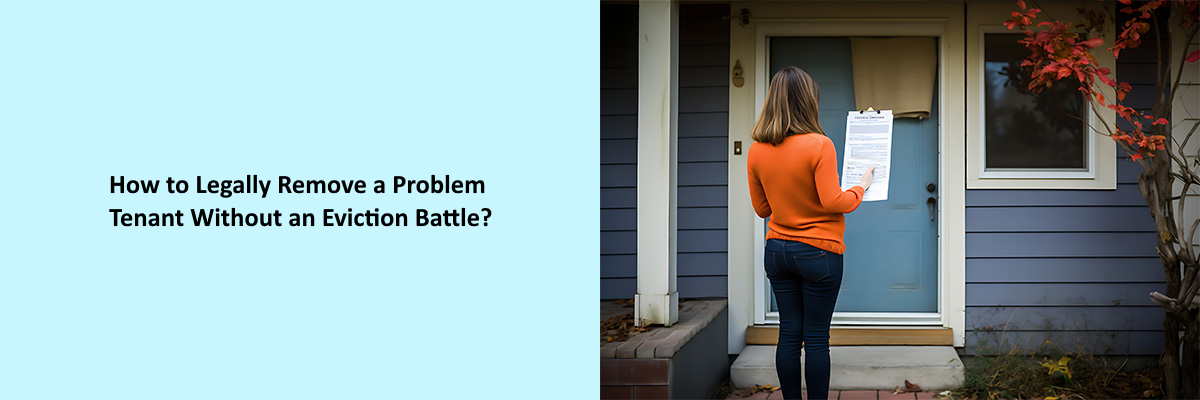For landlords and property managers, there’s one type of tenant that keeps them up at night, the problem tenant. These are the individuals who disrupt the peace, damage property, break lease terms, or simply create an ongoing headache that spreads beyond just the landlord-tenant relationship.
Unfortunately, you can’t always spot a problem tenant during the tenant screening process. People present well on paper. But over time, issues begin to surface, and if those issues escalate, they can start affecting not only you but your other tenants and your property’s reputation.
And that’s where the real damage starts. A single problem tenant can lead to other tenants moving out, your online reviews tanking, and future renters avoiding your property entirely because of stories they’ve heard. It’s a ripple effect, and it’s costly.
So how do you handle a situation like this without igniting a legal nightmare or dragging yourself into an eviction battle? Let’s break it down step by step.



Who Is a Problem Tenant?
A problem tenant isn’t just someone who’s a bit messy or occasionally late with rent. It’s someone whose actions start to affect the broader environment, either financially, legally, or socially.
Here are common red flags that signal a tenant may be a serious issue:
From a landlord’s perspective:
- Constant late or missed rent payments
- Property damage beyond normal wear and tear
- Ignoring lease terms (e.g., unauthorized pets, subletting, running a business)
- Refusing to communicate or cooperate
From a property manager’s view:
- Repeated complaints from maintenance or staff
- Hostile or threatening behavior toward management
- Refusal to follow community rules or building policies
From other tenants’ experiences:
- Loud parties, yelling, or regular disturbances
- Harassment, bullying, or threatening behavior
- Unsafe or illegal activity (e.g., drug use, violence, theft)
- Smoking in non-smoking areas or creating health hazards
What makes this more serious is when these behaviors aren’t isolated, but consistent. Over time, they can lead to legal liability, financial loss, and damage to the property’s public image.
How to Legally and Correctly Remove a Problem Tenant
The key to avoiding a messy court battle? Do everything by the book. Don’t cut corners, don’t get emotional, and document everything.
1. Document Everything
Start the moment the problems begin. Keep written records of:
- Lease violations
- Dates of complaints
- Photos of damage
- Email or message threads
- Witness statements (if needed)
If it’s not documented, it didn’t happen, as far as a court is concerned.
2. Issue Formal Written Warnings
Start with a clear, formal warning. This should include:
- Description of the violation
- Reference to the specific lease clause being broken
- A timeframe for correcting the behavior
- The consequences if it continues
This step is often enough to push some tenants to course-correct.
3. Try to Resolve It Amicably
Yes, seriously. Before escalating:
- Have a private conversation
- Try mediation (many states offer free or low-cost landlord-tenant mediation)
- Offer incentives to leave (also known as “cash for keys”)
Offering to forgive back rent or help with moving expenses may sound frustrating, but it’s often cheaper and faster than court.
4. Use a Legal Termination Notice (When Necessary)
If violations continue, issue the correct notice to terminate tenancy. This must:
- Follow your state’s laws to the letter
- Include the correct number of days (e.g., 3-day notice to cure or quit, 30-day termination, etc.)
- Be delivered properly (certified mail, posted on the door, and/or handed directly, check local law)
This step must be 100% compliant. One mistake can reset the clock or invalidate your entire case.
5. Avoid Retaliation or Harassment
Don’t:
- Shut off utilities
- Enter the unit without notice
- Change the locks
- Harass or threaten the tenant
These are illegal in every state and could result in you being sued, even if the tenant is the one misbehaving.
6. If All Else Fails: File for Formal Eviction
If you’ve exhausted all other options and the tenant refuses to leave or comply, filing for eviction may be your only choice.
- File the eviction paperwork at your local courthouse
- Be prepared to present your documentation
- Follow through with all legal timelines
Yes, it’s time-consuming, but doing it by the book protects your property and reputation.
7. What If the Tenant Ignores Your Notice?
If the tenant doesn’t acknowledge or “misses” the notice, it doesn’t invalidate it as long as you served it legally. This is where delivery methods like certified mail, process servers, or posting the notice with a witness matter. You can’t force them to read it, but the law assumes they’ve been informed if you followed proper procedures.
If the situation escalates or becomes unsafe, involve local law enforcement or a legal advisor before taking further action.
Conclusion
Removing a problem tenant is never fun, but it’s a necessary skill for any landlord or property manager who wants to protect their property, their tenants, and their peace of mind.
The smartest move you can make is to stay professional, follow legal processes, and document everything. If you act out of emotion or skip steps, you’ll give the problem tenant leverage, and that’s exactly what you don’t want.
Good property management practices can make a huge difference in how smoothly the eviction process goes.
Handle it right, and you maintain control of the process without turning it into a war. Handle it wrong, and you’re the one who ends up paying the price, in time, money, or worse.
Your goal isn’t just to remove the tenant. It’s to protect the value of your rental property, your reputation, and the community you’re trying to build.
Want to ensure full compliance with fair housing laws? Explore our Fair Housing Webinars to stay informed and avoid costly mistakes.


